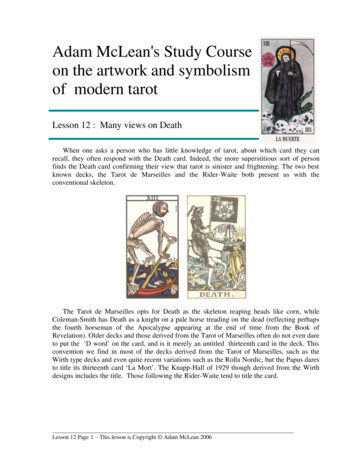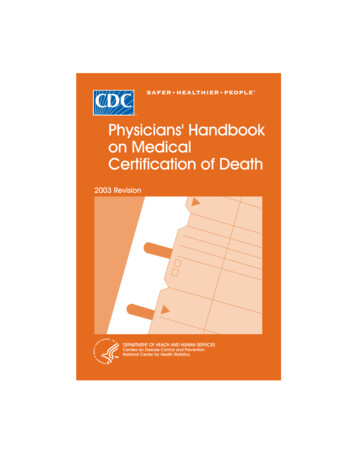
Transcription
Death Welcomes EveryoneSanta Muerte (Holy Death or Saint Death) is the female personification ofdeath. This powerful and mysterious folk saint provides blessings includingsafe passage to the afterlife. Santa Muerte is the patron saint of those wholive on the fringes of society, as well as those who face violence and death.She is hailed as a potent and powerful guardian and protector. Death is thegreat equalizer, and Santa Muerte potentially grants miracles to anyone andeveryone.Santa Muerte is a complete ritual guide to working with this famous—andinfamous!—Mexican folk saint. Go beyond the sensational headlines to discover the truth about why Santa Muerte is so beloved by so many. AuthorTracey Rollin presents simple, straightforward methods for working withHoly Death that may be used alone or easily incorporated into your ownmagical practice.“Tracey Rollin’s very well written book Santa Muerte: The History, Rituals, andMagic of Our Lady of the Holy Death avoids a dogmatic approach to SantaMuerte. The author, who hails from New Mexico, whereDoña Sebastiana, Lady Death, presaged Santa Muerte,incorporates more research on Santa Muerte thanother books aimed at devotees.”—Professor R. ANDREW CHESNUT,author of Devoted to Death:Santa Muerte, the Skeleton Saintwww.redwheelweiser.comU.S. 16.95
This edition first published in 2017 by Weiser Books, an imprint ofRed Wheel/Weiser, LLCWith offices at:65 Parker Street, Suite 7Newburyport, MA 01950www.redwheelweiser.comCopyright 2017 by Tracey RollinAll rights reserved. No part of this publication may be reproducedor transmitted in any form or by any means, electronic or mechanical, including photocopying, recording, or by any informationstorage and retrieval system, without permission in writing fromRed Wheel/Weiser, LLC. Reviewers may quote brief passages.ISBN: 978-1-57863-621-1Library of Congress Cataloging-in-Publication Data available uponrequestCover design by Kathryn Sky-PeckInterior by Frame25 ProductionsTypeset in Adobe DevanagariPrinted in CanadaMAR10 9 8 7 6 5 4 3 2 1
C ha p t e r 1Introducing Santa Muerte,the Skeletal Lady of MexicoWho Is Santa Muerte?Santa Muerte, or “Holy Death” in Spanish, is a folk saint who isbelieved to be the feminine embodiment of death. Her modernform comes to us from Mexico, where she is styled as a femaleGrim Reaper figure. She is often depicted as a skeleton wearing along robe and carrying a scythe, but with added feminine featuressuch as jewelry, flowers, and flowing hair. Her devotees describeher as a warm, friendly, and convivial spirit who is delighted bythe antics of the living and who enjoys interacting with them.Santa Muerte has power over everything that can be touchedby death and decay, which gives her an incredibly broad scope ofinfluence. Since life flowers before it fades, Santa Muerte curesillnesses and addiction. Since fortunes can quickly change, sheshowers her devotees with money and prosperity and untangleslegal problems. She also provides ironclad protection from harm,cutting short with her scythe the curses and maledictions of
others. Because death touches on everything, her knowledge andwisdom are unparalleled. She empowers her devotees to deepentheir understanding and strengthen their creativity; like necessity,mortality is the mother of invention. Because death touches everyone, she may also throw open the doors of social influence as wellas attract a wide variety of lovers. Santa Muerte holds the keys tothe underworld as well as other planar realms, and she may unlocktheir gates to allow communication with spirits of the dead as wellas other entities. Since death and dying both have the power totransform your consciousness, Santa Muerte is also a powerfulpatron spirit of magic. She may assist in shaping and empoweringthe consciousness of devotees, deepening their wisdom, strengthening their willpower, and expanding their awareness. These threethings translate to increased magical power, making Santa Muertethe natural ally of both witches and magicians.Even this is not an exhaustive list of Santa Muerte’s broadportfolio of powers. Because she is the face of death incarnate,her capacity to act is limited only by her devotees’ capacity to ask.It is deeply ingrained within many of us to openly deny what wereally want because we are afraid of being viewed as greedy, sinful, or cynical.For example, many people ask spirits for help with winningmoney in the lottery. Often these requests are filled with promises to use the winnings to help the less fortunate, such as givinglarge sums of money to charity. If this is done honestly as a formof spiritual bribery, it can be quite effective. Some spirits respondwell to being paid for their services, such as with charitable donations made publicly in their name. However, making such promises to simply mask your greed will actually have two differenteffects. First, spirits tend not to respond well to deception. Not2SA N TA M U E R T E
only is being deceptive itself very rude, but you are also telling thespirits that you think they are stupid enough to be deceived. Sinceno one likes being insulted, spirits will respond poorly—if at all.Second, making such promises also weakens the powerof your request, since you are wasting time and energy tryingto convince a spirit that you truly desire to donate millionsto charity when actually you don’t. Since this attempt will failanyway, making these kinds of false promises is an ultimatelyself-defeating practice. Many people try these tactics because webelieve that friendly and helpful spirits will not help a personwhose desire to win the lottery is rooted in greed, as greed isthought to be destructive and evil. The kind of spirit that wouldfulfill such a request is often not the kind of spirit that many people would choose to ask for help.Santa Muerte is notable because she is not concerned with theunderlying motivations driving the requests of her devotees. Sheassigns no particular moral weight to any kind of request, because,to death, everything is a zero-sum game. Whether you dedicateyour lottery winnings to feeding the homeless or to retiring to abeach in Fiji, you will still die in the end. Therefore, Santa Muerteis far more likely to respond to a greedy but heartfelt request thanone that is diluted by fake feelings of altruism. Because she is sononjudgmental, her willingness to intervene is limited only byher devotees’ willingness to ask for her help. Because she assignsno moral weight to any kind of request, her response also extendsto using her power to harm other people. This has led to SantaMuerte’s condemnation by religious and civil authorities and toher followers often being considered suspect.It is the destructive side of Santa Muerte that has helpedher garner so much attention in recent years. The US FederalI N T R O D U C I N G SA N TA M U E R T E3
Bureau of Investigation labels Santa Muerte as a “narco-saint”that is idolized by drug traffickers; it blames her cults for shocking acts of violence and ritual slayings committed on both sidesof the US–Mexico border. Cults dedicated to Santa Muerte frequently operate within drug cartels because it is believed thatshe will grant their members supernatural protection and aid.The media often sensationalizes stories of her statues found ingraveyards and at roadsides, apparently left there as componentsof spells designed to harm specific targets. Her veneration is notcondoned by the Catholic Church. In fact, the Catholic Churchcondemns Santa Muerte as a Satanic figure.To the police, the appearance of Santa Muerte at a crimescene presents a dark omen indeed. During an interview witha law enforcement official from New Mexico, I was told about alocal drug bust conducted by the US Drug Enforcement Administration. While raiding a cartel compound, the agents found anentire room turned into a temple dedicated to the worship ofSanta Muerte. The main feature of the temple was a Santa Muerte“statue” made out of a female skeleton wearing an elaborate blacksilk wedding dress. The official explained to me the primary reasonthat authorities fear Santa Muerte cults and thus specifically targetthem for eradication. It’s not that they fear supernatural repercussions. What they fear is how reckless and violent drug traffickerscan become when they believe they have supernatural protection.Such a criminal is incredibly dangerous and capable of anything. Inan attempt to curb cartel violence, the Mexican military specifically targets Santa Muerte shrines for demolition in an attempt todemoralize drug cartel members. Even if the authorities do notbelieve in Santa Muerte, they are forced to respect her power.4SA N TA M U E R T E
Santa Muerte’s official condemnation has done little toslow her meteoric rise in popularity. Interest in Santa Muertehas exploded in recent years, fueled by increased immigrationand sensationalized media reports linking her to the activitiesof drug trafficking cartels. This increased exposure has helpedSanta Muerte successfully transition from being a mere folk saintto being a virtual pop culture icon.For example, in the popular television series Breaking Bad, theseason three episode “No Más” opens with two cartel assassinsbelly-crawling through a dusty village to pray at a Santa Muerteshrine. She has also been featured in the popular television seriesAmerican Horror Story, Criminal Minds, and Dexter, among others.The character of La Muerte in The Book of Life, a 2014 movie,appears to be based on her.Her image adorns virtually every kind of product imaginable, from ashtrays to gun grips to wall hangings, and the market is enormous. Since the emergence of her first public shrineat Tepito, Mexico, in 2001, the number of Santa Muerte devotees in the world has increased dramatically, currently numbering between ten and twelve million worldwide. In fact, belief inSanta Muerte is the fastest-growing new religious movementemerging in the world today.1Where Does Santa Muerte Come From?The veneration of Santa Muerte comes to us from Mexico, whereshe is publicly celebrated as the patron saint of the Day of theDead. Mexico is a predominantly Catholic country. Catholics1. Andrew Chesnut interview with Allison McNearney, “The Death-WorshippingCult of Santa Muerte,” The Daily Beast, 11/1/15, he-death-worshipping-cult-of-santa-muerte.htmlI N T R O D U C I N G SA N TA M U E R T E5
believe in a wide variety of saints. Saints are spiritual personalities who are believed to have an especially close relationshipwith God. Catholics pray to saints because they can use this special relationship to intercede in the lives of people. The Catholic Church recognizes over 1,500 official saints with new onescanonized annually. To become a saint, a deceased person mustmeet certain criteria, such as performing a number of miraclesthat can be directly attributed to him or her. Only after a lengthyinvestigation by a Vatican commission may a person be canonized and added to the official roll of Catholic saints.However, the Catholic Church does not accept all saints.There are many saints whose ability to perform miracles isacclaimed by popular belief, but they have not been vetted bya Vatican commission. These kinds of saints are called “folksaints.” Despite their unofficial status, the Catholic Church tendsto tolerate their veneration alongside the veneration of the official Catholic patrons.One such example is the folk saint La Difunta Correa (“theDeceased Correa”), who enjoys a cult over two hundred thousand members strong in Argentina, Chile, and Uruguay. LaDifunta Correa is believed to be the spirit of a woman who tookher infant child on a mission to rescue her husband in the 1840s;however, she became lost in the desert and died of thirst beforeshe could reach him. Eventually, some ranchers found her bodyand discovered that her baby was still alive because he was ableto feed from her eternally full breast. Considering this to be amiracle, the ranchers buried her body and told many other people about it. Soon La Difunta Correa’s gravesite became a shrine.Today she is venerated as a patron saint of cattle drivers, travelers, and small children. Her devotees bring her gifts of water6SA N TA M U E R T E
to slake her eternal thirst. La Difunta Correa is classified as afolk saint because she is not recognized by the Catholic Church,despite the popularity of her cult.Santa Muerte is also venerated as a folk saint. Because deathis the great equalizer, Santa Muerte is the patron saint of marginalized people who live on the fringes of society, many ofwhom suffer from rejection by the mainstream culture. Thesepeople include not only the working poor, but also criminals,drug addicts, gay people, prostitutes, single mothers, the homeless, and the mentally ill. She is also often considered the patronsaint of people who work at night, such as taxi drivers, bartenders, exotic dancers, and after-hours cleaning and maintenancestaff. These types of workers are at higher risk for accidents,assaults, robberies, and all types of violent death specificallybecause they work at night. Santa Muerte is often called Senorade la Noche (Spanish, “Lady of the Night”) because believers hopethat she will protect them from these types of calamities. Sincepeople who live on the fringes of society often feel that they havenowhere else to turn, Santa Muerte is sometimes also called theSaint of Last Resort.The Different Names of Santa MuerteSanta Muerte enjoys a large number of titles bestowed onher by her devotees. Following is a list of some of her morecommon ones, along with a brief explanation of each. Several of them bear a marked similarity to each other, so theyare grouped together. Please note that none of these titlesI N T R O D U C I N G SA N TA M U E R T E7
refer to a specific color aspect of Santa Muerte, but to SantaMuerte in general.Holy Death: The literal translation of “Santa Muerte”into English is Holy Death.Our Lady of the Holy Death: Some believe that astrong relationship exists between Santa Muerte andthe Virgin Mary. This title is a play on the name of oneof the most popular versions of the Virgin Mary named“Our Lady of Guadalupe.”Pretty Girl: Santa Muerte’s natural vibrancy is sometimes expressed through a girlish attitude. She isoften called pretty, among other things, to flatter andimpress her.Queen of Death/Saint of Death: These two populartitles subtly imply the great overarching power that SantaMuerte possesses, as even the official Catholic saints overseeing death only manage steps in the process of dying,not the entire experience (more on this in chapter 3).Saint of Last Resort: Because so many people findcalling on death to be an act of desperation, SantaMuerte is sometimes called the Saint of Last Resort.Senora de la Noche (Spanish, “Lady of the Night”):Santa Muerte is thought to be the patron of those whowork at night and are at increased risk of violence anddeath for it.Skeletal Lady/Skeletal Saint/Skinny Girl: Many titles ofSanta Muerte refer to her thin and skeletal appearance.Sister/Mother Death/Bone Mother: These popularterms usually refer to the gentler and more caring facesof Santa Muerte.8SA N TA M U E R T E
White Sister/Lady/Mother—These terms that call SantaMuerte white do not refer to her actual color, but to thestates of newness and purity that she can create instead.Unlike La Difunta Correa, however, Santa Muerte does notenjoy the passive acceptance of the Catholic Church. In fact,the Church outright condemns veneration of Santa Muerte asa Satanic practice. The Catholic Church already has several official saints that are devoted to death, such as Saint Margaret ofAntioch and Saint Michael, so there is no need for Santa Muerteto fulfill that role.Another thing that bars Santa Muerte from being tolerated isthat some of her devotees engage in illegal activities and practiceblack magic. Since Santa Muerte is the patron saint of criminalsand those who are at risk of nighttime violence, many drug traffickers hail her as their personal patron and use spells and rituals to ensure their protection and success. While similar activityis sometimes performed in the name of Saint Jude, who is thepatron saint of lost causes, this type of activity is frowned on atbest and often condemned as Satanic. The criminal behavior ofsome of Santa Muerte’s devotees makes it difficult for her cultto gain the acceptance and tolerance that the cults of other folksaints enjoy.As drug-related violence continues to escalate on both sidesof the US–Mexico border, Santa Muerte cults associated with thedrug trafficking cartels are blamed for murders allegedly conducted in order to curry her favor. Some of her cults have evenbeen accused of engaging in ritual cannibalism! This behavior hasI N T R O D U C I N G SA N TA M U E R T E9
caused Santa Muerte to become inextricably linked in the minds ofmany with violent slayings conducted to fuel black magic, leadingto her condemnation as a Satanic figure. Despite the fact that thesedevotees would likely describe themselves as devout Catholics andSanta Muerte herself as being in league with God, these types ofactivities are understandably repulsive to the Catholic Church.Since the Catholic Church has no need to add an additional saintto its official register, especially one who is associated with violentcriminals who practice black magic, the Catholic Church continues to denounce Santa Muerte as a Satanic figure.Traditionally, veneration of Santa Muerte has been a privatepractice, partially because of condemnation by civil and religious authorities and partially because of the negative connotations associated with her worship. Because of the strong Catholicinfluence, Mexico also has strong cultural taboos against usingwitchcraft, especially for malign purposes. People who usewitchcraft risk social ostracism or worse, as it is often equatedwith malevolence. Many perceive turning to the power of Deathitself for aid as an act of desperation.The Mexican government, like the Catholic Church, tendsto tolerate the veneration of folk saints. There is even one folksaint, El Niño Fidencio, whose veneration has spawned its ownoffshoot religion called the Fidencista Christian Church with itsown liturgy and church hierarchy. This church was founded in1993, and its membership continues to grow to this day. SantaMuerte enjoys no such unofficial tolerance, however. Her firstpublic shrine did not open until 2001 in Tepito, Mexico. TheMexican government continues to refuse to recognize the movement as an official religion, citing concerns that doing so wouldonly legitimize veneration of Santa Muerte in the eyes of the10SA N TA M U E R T E
drug cartels. Thus, there is no “official” Santa Muerte cult or religion with a standardized body of prayers or ritual practice.Although the Catholic Church has condemned the veneration of Santa Muerte, this has not prevented her from becomingthe unofficial patron saint of the annual Day of the Dead celebration in Mexico. The Day of the Dead, or Dia de los Muertos, is anational holiday when the souls of the dead are thought to returnto enjoy the pleasures of life as well as the closeness of family andfriends. Rather than a somber occasion, the Day of the Dead isintended to be a bright and jubilant one. People gather to celebrate the spirits of their deceased loved ones and the lives thatthey lived. This celebration is not only believed to strengthen thebonds of family but is also an opportunity to ask the dead fortheir assistance and protection. Cleaning and tending graves isa common activity as well, with many people leaving flowers,food, and other gifts for the dead to enjoy.In many Catholic countries during religious festivals, theicons of cherished saints are removed from their shrines andparaded around streets and public squares so that they receivethe adoration of the faithful. Because Mexico is a predominantlyCatholic country and Santa Muerte is hailed as a folk saint, sheenjoys the same treatment that the other saints receive. The Dayof the Dead is held on November 2, which coincides with AllSouls’ Day—a Catholic religious holiday when the faithful prayfor the souls of their dearly departed dead. On the Day of theDead, the Saint of Death makes her celebrated public appearance. Her statues are arrayed in richly embroidered robes andcovered with garlands of flowers before being taken out of theirshrines and paraded throughout town. Many such processionsend in the local graveyard, often with much singing and dancing.I N T R O D U C I N G SA N TA M U E R T E11
The Day of the Dead celebration is rooted in a much olderreligious festival that was celebrated by the Aztecs. When theSpanish arrived in 1519, the Aztecs dominated the Valley ofMexico. The Aztecs celebrated several of their gods of death andsacrifice during their end-of-year harvest festivals. They also celebrated the memories of their own dead, often equating butterflies or moths with the returning souls of family and friends. Onedeity celebrated during these festivals was the goddess Mictecacihuatl, the Lady of Mictlan.Mictlan is the Aztec underworld, a dark and dangerousplace that the dead had to navigate to find her fortress to awaittheir eventual rebirth. When the Spanish converted the Aztecsto Catholicism, the native population refused to stop the veneration of their dead. Eventually, the Catholic priests yielded—they were able to compromise by moving the calendar date ofthe Aztec festivals to coincide with All Souls’ Day. In this way,elements of those ancient Aztec festivals survived to become themodern Day of the Dead celebrations.The goddess Mictecacihuatl is frequently cited as a mythicsource of Santa Muerte, although some scholars point out that itis unclear why this particular deity was elevated out of the manyavailable Aztec gods of death and sacrifice. Despite this argument, many devotees consider belief in this origin story to be amatter of cultural and ethnic pride, since an Aztec origin createsa tangible connection to Mexico’s pre-Spanish past.Many scholars and devotees point out that the idea of afemale death figure was also not unknown to the Spanish whocolonized Mexico. In the 14th century, a great plague knownas the Black Death decimated Europe, killing 30 to 60 percentof the population. As survivors tried to cope with the horror of12SA N TA M U E R T E
so much widespread death, their cultural focus turned towardthemes of dying, resurrection, and penitence. It also evoked astrong desire for a gentle and peaceful death. The idea of a GrimReapress arose, a feminine face of death who would deliver suchgentle and peaceful endings. The term and spelling “Grim Reapress” first appeared in Devoted to Death by R. Andrew Chesnut.The Spanish recognized this figure within their culture,referring to her as La Parca (Spanish, “the parched one”).Europe’s population did not recover its 14th-century populationlevels until the 17th century, two hundred years after the Spanisharrived in Mexico. Thus, the concept of La Parca was still vibrantand relevant within Spanish culture when they established theircolonies. Since Santa Muerte takes the form of a female GrimReaper, in the same way as La Parca, many devotees cite this asevidence that Santa Muerte’s roots are European instead.Although these two theories are the dominant ones concerning the origins of the Saint of Death, they are not the only ones.The decentralized nature of Santa Muerte’s veneration has givenrise to a number of alternative theories of origin for the Saint ofDeath that draw less support but are believed just as sincerelyby those who have adopted them. One such myth is that SantaMuerte is the elevated soul of a beautiful woman who committedsuicide after being rejected by her lover. God denied her entryinto Heaven because she committed suicide but took pity on herby giving her the task of collecting the souls of the dead insteadof consigning her to Hell. This is why Santa Muerte is believedto have such a sympathetic and loving nature. This theory alsomakes it possible for Santa Muerte to have personally collectedthe soul of Jesus Christ, a fervent belief of some of her devotees,I N T R O D U C I N G SA N TA M U E R T E13
but which makes little sense if Santa Muerte first arose in AztecMexico or late medieval Europe instead.Another theory of origin places Santa Muerte’s roots inAfrica. When Yoruba slaves were brought to the Americas,they brought their religious beliefs with them, which eventuallyemerged as the African ritual traditions, Palo Mayombé, Santeria, and Vodou. Since some traditional Santa Muerte practices closely resemble African ritual traditions, some devoteesof Santa Muerte contend that she is related to one of the manyAfrican goddesses of cemeteries and rebirth.In Santeria, the African-diaspora tradition of Cuba, two orishas (powers), who are both goddesses, are associated with death: The orisha Yewa is the goddess of the underworld,who is charged with bringing the bodies of thedead to Oya. The orisha Oya is the goddess of cemeteries, as wellas storms and rebirth.Palo Mayombé, an African-diaspora tradition also arising inCuba, has a deity or spirit named Centella Endoki, who is similarto Oya, as is Maman Brigitte, a spirit of Haitian Vodou.Since Yoruba slaves were brought to Mexico as well as theCaribbean, believers in this origin theory of Santa Muerte citeit as the opportunity for yet another patroness of cemeteries toemerge as a result of the African diaspora.These are just two additional alternative theories of SantaMuerte’s origin. The decentralized nature of Santa Muerte’s culthas allowed for many different myths to proliferate. AlthoughSanta Muerte’s modern face is undoubtedly Mexican in origin, her14SA N TA M U E R T E
diverse roots make it easy for anyone to relate to her in a mannercloser to the cultural perspective in which they were raised.For example, my mother is a Catholic immigrant from Germany. When I was a little girl, I learned from her about a friendlyNorse goddess of the underworld named Hela. This goddess wassupposed to be very lovely, except that half of her face was anexposed skull. Her divine duty was to care for the souls of thegently departed dead, which included women, children, and theelderly. This story became part of my personal cultural perspective and mythological makeup, as much as the Catholic saintsthat my mother also taught me to venerate.Although I grew up in New Mexico, I did not learn aboutSanta Muerte until I was an adult. Even so, I found it easy toaccept the idea of a friendly and beautiful skeletal lady saintbecause she reminded me so strongly of the stories of Hela that Ihad learned as a child. While my route to the veneration of SantaMuerte may have been an unusual one, it is a striking testament to the universal appeal that the Saint of Death holds. Oncestitched together, the many different devotees of Santa Muertemake an interesting and varied fabric indeed.San la MuerteSan la Muerte is another major Latin American spiritual beingassociated with death. Similar to Santa Muerte, his name ortitle also translates as “Holy Death” from Spanish, albeit in amale-gendered form. San la Muerte, who is also portrayed as ablack-robed skeleton with a scythe and an owl, is venerated inParaguay, Argentina, and parts of Brazil.The roots of San la Muerte are murkier than those of someother popular Latin American folk saints who are associated withI N T R O D U C I N G SA N TA M U E R T E15
death—for example, La Difunta Correa, who was discussed earlier and who is reputedly the spirit of a woman who died in the1840s; or Miguel Ángel Gaitán, who died fifteen days before hisfirst birthday in 1967 and whose incorruptible body lies encasedwithin its glass tomb in Chilecito, Argentina.There are two competing origin stories for San la Muerte. Onemyth is that he was a particularly powerful curandero, an herbalistand mystical healer, who received his great ability from his devotion to Jesus Christ. After his death, this holy man’s spirit persisted to help others. His cult elevated him to the position of GrimReaper, believing that his position on the other side of death’s veilallows him to see into the hearts of the living, and so he is capableof judging them. This version of the story creates him as initiallyboth male and mortal, granted great power only because of hisextreme dedication to his faith. This is very different from theorigin stories of Santa Muerte, which almost exclusively describeher as being the face of a fundamental and universal power andtherefore not the elevated soul of anyone in particular.The other myth explaining the origin of San la Muerte ismuch more interesting. After Jesuit missionaries converted theGuarani Indians of Paraguay, Argentina, and Brazil, they beganto receive abundant offerings of gold and jewels. The Guaranialso labored to build numerous churches throughout the region.The legend goes that not all of the Guarani truly adopted theforeign God of the Jesuits. To continue their own practices insecret, they gave to the Jesuits a great carved statue of Jesus Christ,the Devil, and Death done in a native style. They included withinthe elaborate carvings symbols of their patron gods and spirits,hiding them right under the priests’ noses. The statue was reputedly carved out of the heart of a palo santo (Spanish, “holy wood”)16SA N TA M U E R T E
tree. The palo santo tree grows throughout Central and SouthAmerica and is popularly believed to attract beneficial spirits anddrive off malignant ones. It has particular significance for the Guarani, who believe that trees possess great power to affect humanbeings because their gods had created the foundations of the worldfrom special woods. Palo santo was favored for the most powerfulor significant carvings because t
believe in a wide variety of saints. Saints are spiritual person-alities who are believed to have an especially close relationship with God. Catholics pray to saints because they can use this spe-cial relationship to intercede in the lives of people. „e Catho-lic Church recognizes over 1,500 o–cial










